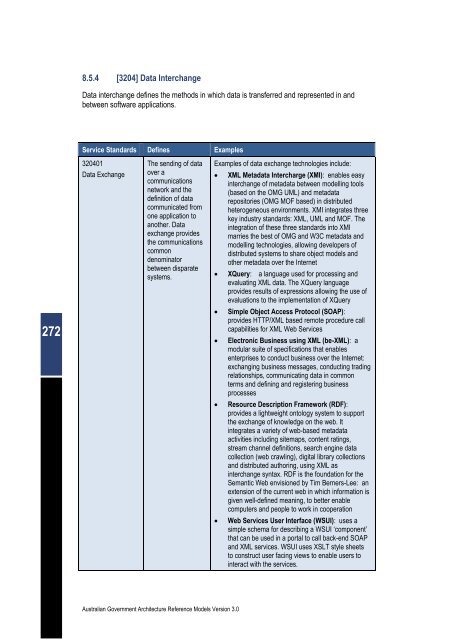Australian Government Architecture Reference Models Version 3.0
Australian Government Architecture Reference Models Version 3.0
Australian Government Architecture Reference Models Version 3.0
Create successful ePaper yourself
Turn your PDF publications into a flip-book with our unique Google optimized e-Paper software.
272<br />
8.5.4 [3204] Data Interchange<br />
Data interchange defines the methods in which data is transferred and represented in and<br />
between software applications.<br />
Service Standards Defines Examples<br />
320401<br />
Data Exchange<br />
The sending of data<br />
over a<br />
communications<br />
network and the<br />
definition of data<br />
communicated from<br />
one application to<br />
another. Data<br />
exchange provides<br />
the communications<br />
common<br />
denominator<br />
between disparate<br />
systems.<br />
<strong>Australian</strong> <strong>Government</strong> <strong>Architecture</strong> <strong>Reference</strong> <strong>Models</strong> <strong>Version</strong> <strong>3.0</strong><br />
Examples of data exchange technologies include:<br />
� XML Metadata Intercharge (XMI): enables easy<br />
interchange of metadata between modelling tools<br />
(based on the OMG UML) and metadata<br />
repositories (OMG MOF based) in distributed<br />
heterogeneous environments. XMI integrates three<br />
key industry standards: XML, UML and MOF. The<br />
integration of these three standards into XMI<br />
marries the best of OMG and W3C metadata and<br />
modelling technologies, allowing developers of<br />
distributed systems to share object models and<br />
other metadata over the Internet<br />
� XQuery: a language used for processing and<br />
evaluating XML data. The XQuery language<br />
provides results of expressions allowing the use of<br />
evaluations to the implementation of XQuery<br />
� Simple Object Access Protocol (SOAP):<br />
provides HTTP/XML based remote procedure call<br />
capabilities for XML Web Services<br />
� Electronic Business using XML (be-XML): a<br />
modular suite of specifications that enables<br />
enterprises to conduct business over the Internet:<br />
exchanging business messages, conducting trading<br />
relationships, communicating data in common<br />
terms and defining and registering business<br />
processes<br />
� Resource Description Framework (RDF):<br />
provides a lightweight ontology system to support<br />
the exchange of knowledge on the web. It<br />
integrates a variety of web-based metadata<br />
activities including sitemaps, content ratings,<br />
stream channel definitions, search engine data<br />
collection (web crawling), digital library collections<br />
and distributed authoring, using XML as<br />
interchange syntax. RDF is the foundation for the<br />
Semantic Web envisioned by Tim Berners-Lee: an<br />
extension of the current web in which information is<br />
given well-defined meaning, to better enable<br />
computers and people to work in cooperation<br />
� Web Services User Interface (WSUI): uses a<br />
simple schema for describing a WSUI ‘component’<br />
that can be used in a portal to call back-end SOAP<br />
and XML services. WSUI uses XSLT style sheets<br />
to construct user facing views to enable users to<br />
interact with the services.

















